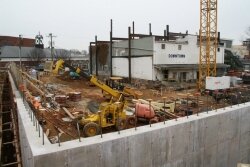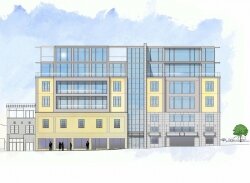Incremental: Waterhouse rises, raises County ire
-
 The Waterhouse project is underway, with a little help from area tax payers and a tax rebate for the developer.Photos by Dave McNair/Rendering courtesy Atwood Architects
The Waterhouse project is underway, with a little help from area tax payers and a tax rebate for the developer.Photos by Dave McNair/Rendering courtesy Atwood Architects -
 The massive crane at Waterhouse went up on January 20Photo by Dave McNair
The massive crane at Waterhouse went up on January 20Photo by Dave McNair -
 Will Waterhouse be a boon to Downtown Charlottesville?Photo by Dave McNair
Will Waterhouse be a boon to Downtown Charlottesville?Photo by Dave McNair -
 The new Waterhouse project will change the face of Water Street.RENDERING COURTESY ATWOOD ARCHITECTS
The new Waterhouse project will change the face of Water Street.RENDERING COURTESY ATWOOD ARCHITECTS
Crews erected a construction crane over Water Street on Thursday, January 20, a powerful visual symbol of the long-awaited (and scaled down) Waterhouse project, a now six-story, $20 million mixed-use complex of offices, retail space, and apartments atop a parking garage that will span the gap between West Water and South Streets.
Two weeks later, a retaining wall has been poured, and steel girders have gone up over and around the former Downtown Tire building, which will be incorporated into the design. Originally, there were plans for a kind of pedestrian village with 57 planned residential units, but the bad economy turned that idea on its head. Now, Waterhouse will become more of a business park, with only nine residential units, and nearly 50,000 square feet of retail and office space, a huge chunk of which WorldStrides and its 200-plus employees are planning to occupy.
Oh, and one more thing. You, dear city tax payer, are going to help pay for the private development.
Back in August, Charlottesville City Council approved something called tax increment financing (TIF) for the Waterhouse project, a method for local governments to fund re-development and “community improvement projects” that has been around for decades. Basically, a percentage of future real estate tax revenue in the area around Waterhouse, revenue which will presumably rise once the project is finished, will be used to help pay down the loan for the project and lower costs for tenants, which in turn increases the likelihood that the development will get built and tenants can be lured in to sign leases.
In Waterhouse’s case, its been a way to convince WorldStrides, the nation’s leading provider of educational travel programs and one of the area’s largest employers, to leave their digs at Peter Jefferson Place on Pantops and move just 2.4 miles to the Downtown Mall. Indeed, without the TIF incentive, it’s hard to imagine why the company would bother moving such a short distance.
And that has some county leaders smarting.
“I think that tax incentives should not be used to lure businesses from the County to the City or vice versa,” says County supe Dennis Rooker, who points out that the WorldStrides incentive will bring no new jobs to the area.
“It’s a zero sum game," says Rooker. "Employment opportunities for the citizens in our area will not be improved by this use of taxpayer money.”
“That’s not how economic development works,” responds Charlottesville mayor Dave Norris. “It’s not like we get to pick and choose who comes to the City when we’re ready for them to come.”
Norris sees nothing wrong with offering a “relatively modest amount of deferred tax revenue” if it can make the difference for a business willing to invest millions in the city.
However, back in July, County supe Ken Boyd told the Daily Progress that the city move was an “inappropriate” way to attract businesses away from the county, by basically subsidizing jobs with tax payer money, especially since the county had to give the city $18 million as part of the Revenue Sharing Agreement.
“It goes both ways,” counters Norris, pointing out that “a tremendous amount” of taxpayer dollars are being spent on public infrastructure to facilitate the relocation of Martha Jefferson Hospital from the City to the County. Norris also points out that the city works closely with surrounding counties through the Thomas Jefferson Partnership for Economic Development to attract and retain businesses in our region as a whole.
“When you look at the number of businesses that left the downtown for the county, lured perhaps by the latest and greatest in shopping centers,” says City councilor David Brown, "I have trouble understanding the big deal about the City having an interest in promoting downtown developments, using, in this case, tax incentives.”
“The City can’t just sit idly by and watch jobs and investment leave to the surrounding counties,” says Norris. “We have to compete for those employers who are going to bring jobs and economic activity, and the resulting tax revenues, to the City.”
Given that the cost of developing property in a built-up urban area is typically higher than in the suburbs, Norris points out, “tools like TIF can help level the playing field and make us more competitive.”
In addition, Norris points out that there are certain commitments the developer has to fulfill before they get the tax rebate.
First, the developer, Atwood Architects, must make the $20 million investment and make sure WorldStrides agrees to occupy the site. After that, 50 percent of the actual change in real property tax (or the tax increment) from the initial value (land) to the current assessed value (land plus improvements) will be granted to the developer.
“We estimate that to be approximately $81,000 a year for five years,” says Chris Engel, the city’s assistant director of economic development. “The actual amounts are determined by the assessor once the project is complete and fully assessed for the first time.”
The rebate only involves the real estate tax, says Engel, and after five years 100 percent of the tax increment will go to the city.
In addition, Engel says, the city will receive revenue from business licenses, personal property tax,, permitting fees, and utility taxes from the new development. Plus, sales and meals tax revenue are expected once all those WorldStrides employees settle in.
Engel also points out that the tax money to the developer comes from the portion of the projected increase in real estate tax revenue.
“If the project is stalled or never completed for any reason, the increase in taxes is not realized,” says Engel, “and therefore the city is not obligated to grant a rebate.”
While officials from WorldStrides did not respond for comment, Engel says the company approached the city regarding the move. As he points out, the company used to be based in the city but moved out to Pantops to accommodate their growth.
While Engel admits that luring a company from outside the area would have provided a more significant boost to the local economy, he says that WorldStrides was considering locations outside the region.
“If they left the area completely the negative effects would have certainly been felt,” says Engel. “This solution keeps them in the area and provides a spark for our downtown during a difficult time.”
“The amount of tax income we forego in this deal is absolutely dwarfed by the amount of taxes that this project and this employer will generate for the City in the long run,” says Norris. “The only scandal here is that it’s taken the City so long to utilize tools like tax increment financing."
8 comments
Buy fresh, buy local!
"You the city tax payer are helping to pay for this". This is a non-issue that the Hook likes to keep dragging along. City taxpayers will greatly benefit in the long-term -- the tax basis for this building will be quite a bit greater than what was there before (mostly, a parking lot). Yes, the real estate tax for the property will be discounted for the first few years, but after that, collections will be much more than they would have been. Everybody wins -- the developer, the city, the tenants, downtown businesses (selling meals, goods, and services to those tenants). The paragraph in this article that describes the TIF is pretty accurate, but the line about city tax payers paying for the project is silly and sensationalistic.
Charlottesville Mayor Dave Norris also appears on the latest Politics Matters episode (a locally produced cable show with host Jan Paynter) in an interview about Charlottesville’s Sister Cities: http://bit.ly/polmatters
Charlottesville Mayor Dave Norris also appears on the latest Politics Matters episode (a locally produced cable show with host Jan Paynter) in an interview about Charlottesville’s Sister Cities: http://bit.ly/polmatters
The comment from the Arblemarble Super is absurd. Why are there no "affordable housing" projects going on there, and none in existence?? Because AC only wants "higher roller" taxpayers, not the bottom of the barrel. I sa, lets send all of our homeless to the County somewhere. See how that plays at the AC courthouse and police station.
First, I must say, the city knows nabsolutely, absolutely nothing about economic development. In the last Comprehensive Plan it removes increasing the tax base and creating new jobs from its definition and changed it to a "question of design." I suppose that means "If you better the design of the city, they will come."
However, the county has stolen many city businesses by having a real estate tax rate that is approximately two-thirds that of the city. The city is using taxes to lure them back.
If theis particular compay was looking to move out of the region, why? Will that reason still be there five years from now when its rent goes up? What's to keep them from moving then? It happened to Buckingham County a few years ago when a tax-subsidized business packed up and left. The city also know absolutely, absolutely nothing about public-private partnerships either. Our Council has always deluded itself by thinking it can play with the big boys.
max brando:
Actually, Albemarle County does have some "affordable housing" projects. The latest is Treesdale Park, an 86-unit "Affordable Multifamily Rental Community" for which ground was recently broken (and all trees murdered) on Rio Road. But County residents probably won't see a successor soon because Charlottesville has lured Treesdale's developer, William Park (partner in the County with AHIP), away to partner on the Ridge-Cherry site with Southern Development. The bait? Two prime parcels of City taxpayer-owned property and Virginia Housing Development Authority Low-Income Housing Tax Credits.
This is really a property flip, of course. SD secured approval in 2009 for William Taylor Plaza, a mixed-use behemoth then already well past its sell-by date in a tanking market. SD has been trying to shed the property ever since. A mad dash began in December to flip the property to Park for a mixed-income behemoth of even more burdensome proportions than the approved SD plan in time for Park to meet a VHDA application deadline in March. (The approved plan featured 50 residential units, including studios, that would be for sale. Park's plan features 80 residential units, not including studios but including three-bedroom units, that would be for rent only.)
Last Tuesday, Planning Commissioners rejected Park's plan as "inferior." But that rejection is only advisory. So unless Charlottesville citizens/voters/taxpayers push back very hard indeed, SD's very good friends on City Council will approve Park's plan at their next meeting -- Tuesday (because of a Monday holiday) February 22nd -- then approve a new sale (for no money) contract for the two City parcels at their next meeting after that.
Comments made by Councilors and Commissioners on Tuesday suggested that neighbors who oppose Park's plan have insufficient sympathy for the plight of others. In fact, the neighborhood is already a fine and functional example of mixed-income living and low-cost housing -- an example that developed naturally. We have truly affordable housing stock. Two houses on the Ridge-Cherry block sold last year for $182,500 and $140,000. Another is for sale now at $165,000.
More to the point, basically within sight of the Ridge-Cherry site, we already have no less than 433 units of low-income rental housing. They're at Friendship Court (150), Crescent Hall (105), Midway Manor (98), South First Street (59), 715 Ridge Street (2), and in four Dogwood Housing properties (19). Then there's the nice upstairs one-bedroom apartment in a well-maintained duplex -- sunlight, front porch, backyard, dog allowed -- right across the street from my Oak Street house ($35,000 in 1987). The rent is $695, well below the Section 8 allowance for a one-bedroom, yet it's gone unrented for six months.
But we really, really need to destroy a steep-sided, wooded, creek-bisected ravine (i.e. valuable natural rain garden) and also need to invest City taxpayer-owned property to build an "inferior" mixed-income behemoth vigorously opposed by the neighbors it would burden, right? One wonders why anyone would want to invest anything in the self-destructive theoretical construct my home town has become.
One hopes construction on the Waterhouse does not end when it is only half finished.